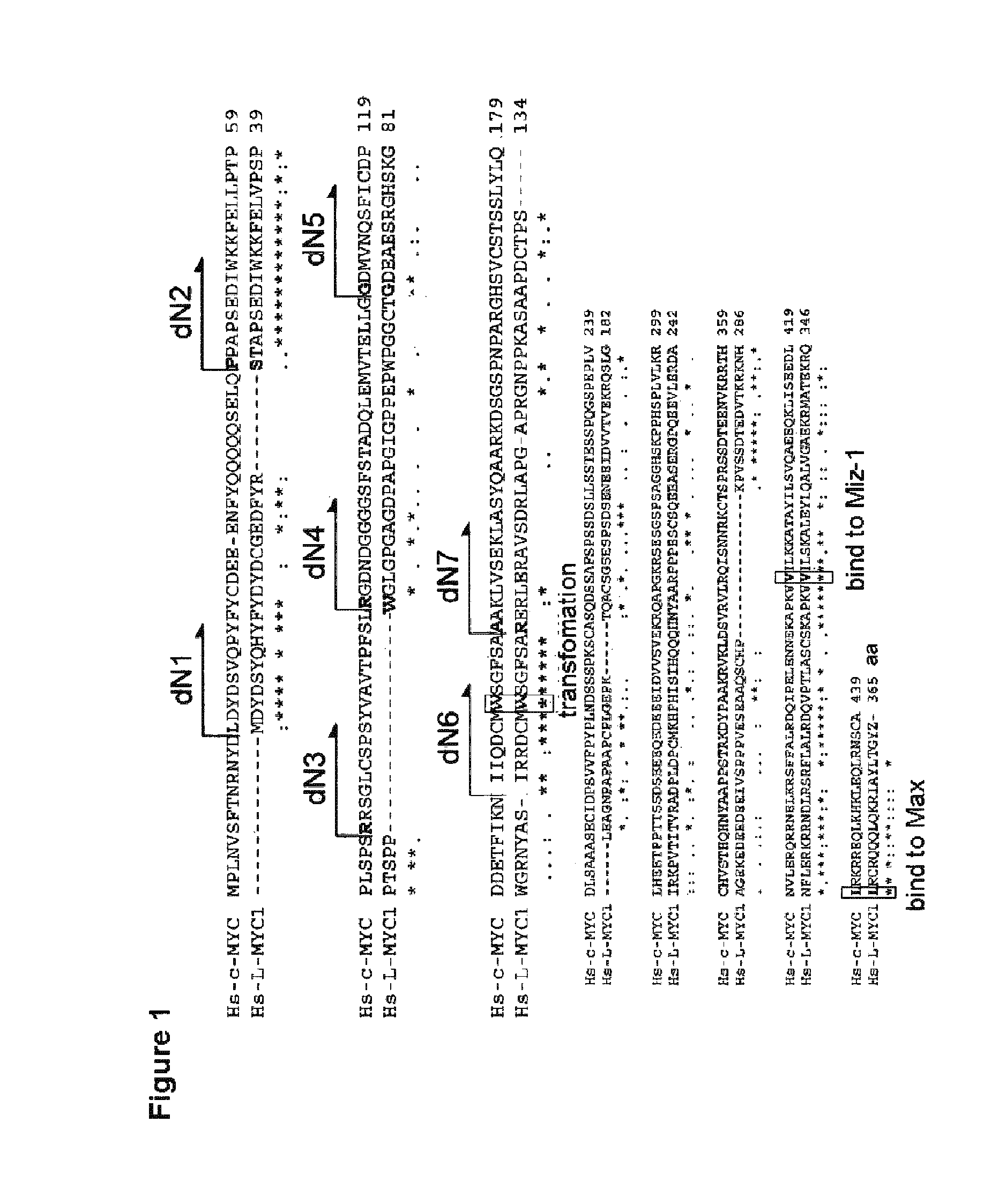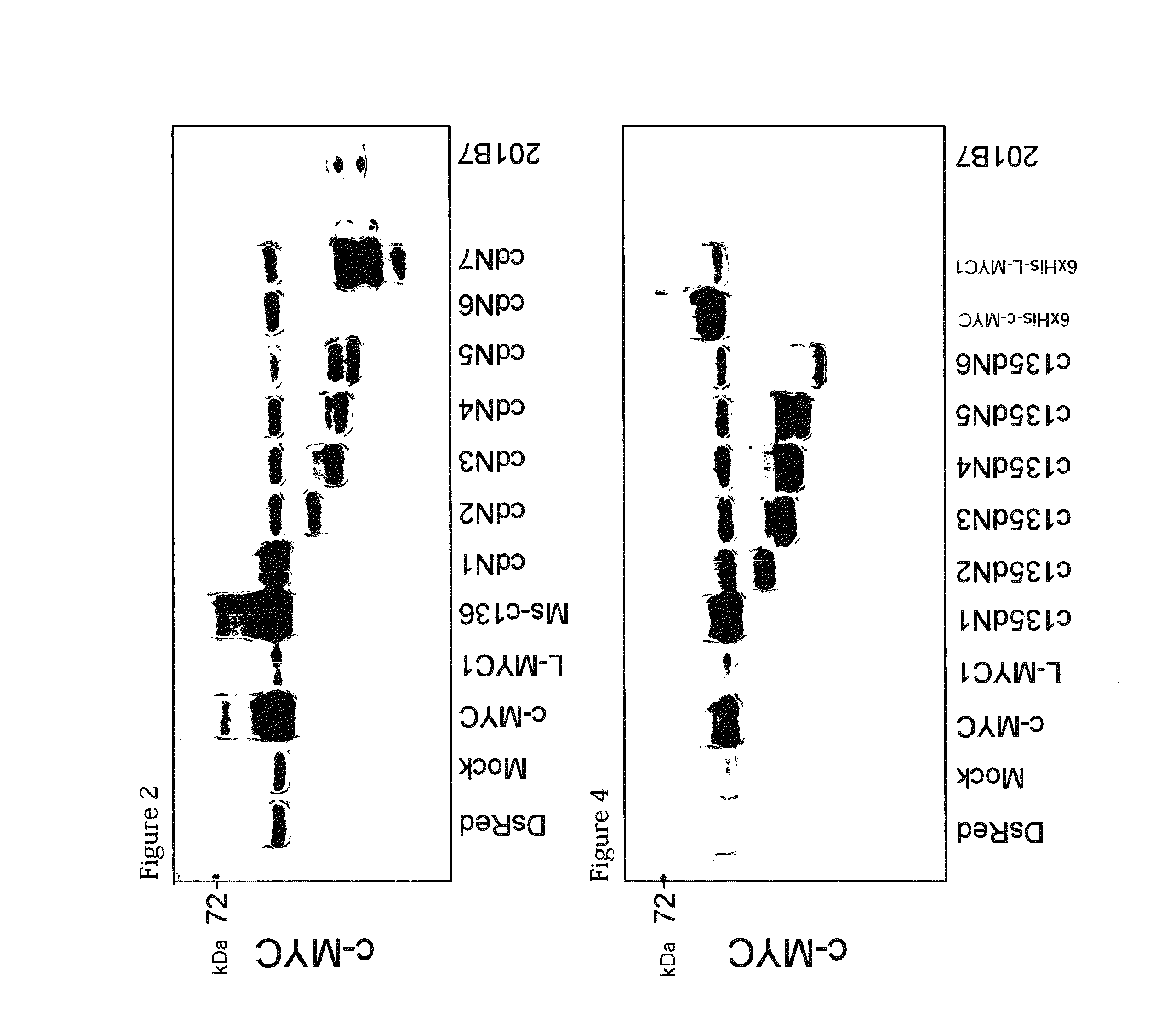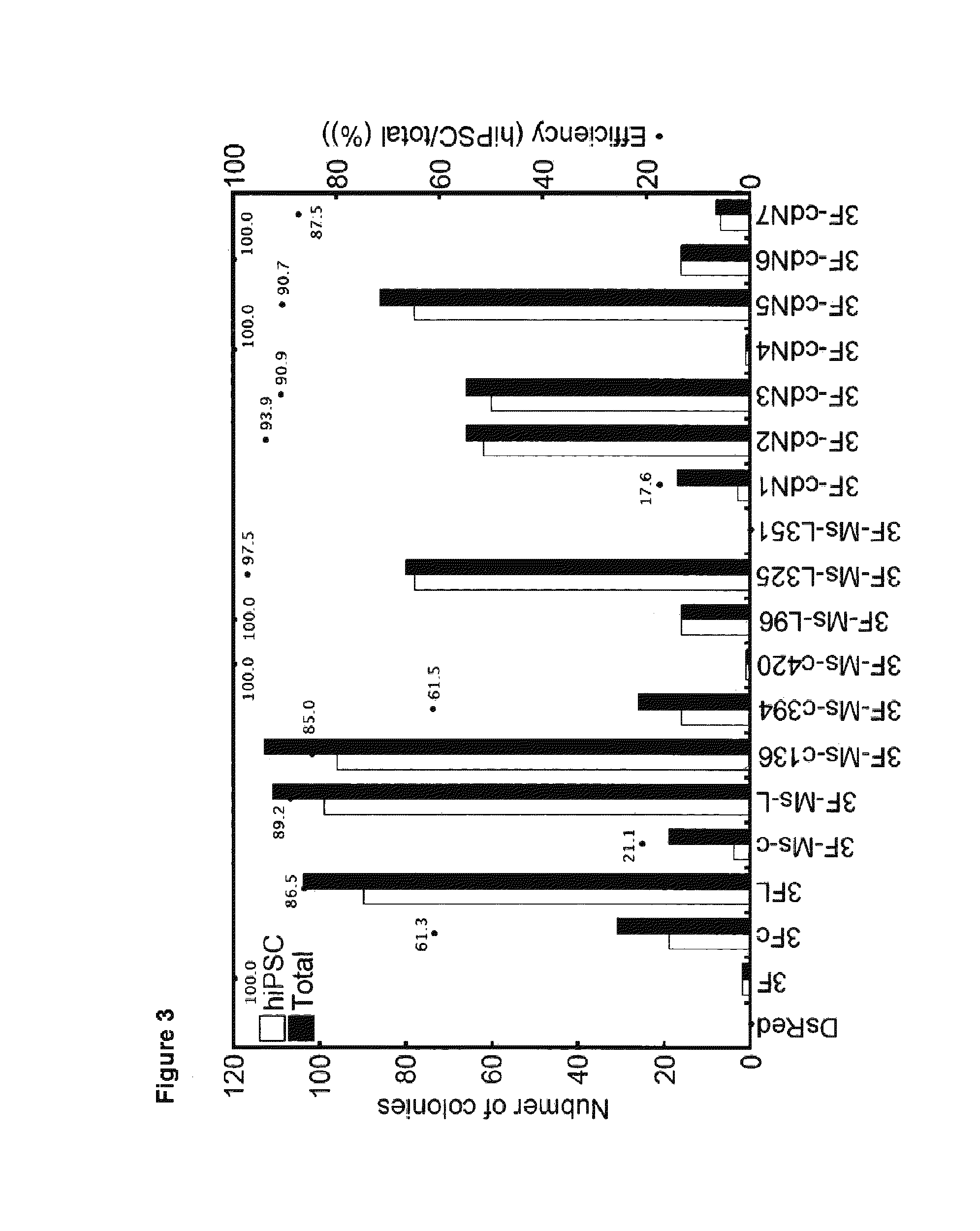Myc variants improve induced pluripotent stem cell generation efficiency
a technology of induced pluripotent stem cells and variants, which is applied in the direction of artificial cell constructs, peptide sources, applications, etc., can solve the problems of no use of the gene and the risk of tumor development of the c-myc gene, and achieve the effect of improving the generation efficiency of ips cells
- Summary
- Abstract
- Description
- Claims
- Application Information
AI Technical Summary
Benefits of technology
Problems solved by technology
Method used
Image
Examples
example 1
Study on Induction of iPS Cells with a Variant of c-MYC having N-terminal Deletion
[0293]1) Preparation of Retroviral Vectors Encoding Variants of Human c-MYC having N-terminal Deletion
[0294]Retroviral vectors encoding variants cdN1 to cdN7 of human c-MYC having N-terminal deletion were prepared. Firstly, fragments were amplified by PCR using human c-MYC cDNA as a template and the following sets of primers.
[0295]
[0296]
(SEQ ID NO: 11)dN1-sCACCATGCTCGACTACGACTCGGTGCAGCC(SEQ ID NO: 12)dN2-sCACCATGCCCCCGGCGCCCAGCGAGGATAT(SEQ ID NO: 13)dN3-sCACCATGCGCCGCTCCGGGCTCTGCTCGCC(SEQ ID NO: 14)dN4-sCACCATGCGGGGAGACAACGACGGCGGTGG(SEQ ID NO: 15)dN5-sCACCATGGGAGACATGGTGAACCAGAGTTT(SEQ ID NO: 16)dN6-sCACCATGATCATCATCCAGGACTGTATGTG(SEQ ID NO: 17)dN7-sCACCATGGCCGCCAAGCTCGTCTCAGAGAA
[0297]
[0298]
(SEQ ID NO: 18)HsMyc-ASTCACGCACAAGAGTTCCGTAGCTGTTCAAG
[0299]The LR reaction between pENTR-D-TOPO-cdN1 to cdN7, which were obtained by cloning each of the resulting fragments into pENTR-D-TOPO (Invitrogen), and retro...
example 2
Investigation of Induction of iPS Cells with a Variant of Human c-W135E having N-terminal Deletion
[0308]1) Preparation of Retroviral Vectors Encoding Variants of Human c-W135E having N-terminal Deletion
[0309]Point mutation of human W135E was introduced by carrying out PCR using pENTR-D-TOPO-cdN1 to cdN6 constructed in Example 1-1) as a template and using primers [OLIGO1: CAGGACTGTATGGAGAGCGGTTTCT (SEQ ID NO:19); and OLIGO2: AGAAACCGCTCTCCATACAGTCCTG (SEQ ID NO:20)]. After the point mutation was verified by sequencing, the LR reaction with retroviral vector pMXs-gw was carried out to prepare pMXs-c135dN1 to c135dN6.
[0310]2) Verification of Expression with Western Blotting
[0311]The retroviral vectors pMXs-c135dN1 to c135dN6 were individually introduced into Plat-E cells, in the same manner as in Example 1-2). Then, western blotting was carried out by a conventional method using a lysate of the Plat-E cells. The results are shown in FIG. 4. From the fact that a band of endogenous c-MYC...
example 3
Investigation of Induction of iPS Cells with Variants of L-MYC Derivatives having N-terminal Deletion
[0314]1) Preparation of Retroviral Vectors Encoding Variants of Human L-MYC having N-terminal Deletion
[0315]Retroviral vectors encoding variants LdN2, LdN4, LdN5, LdN6 and LdN7 of human L-MYC having N-terminal deletion were prepared (excepting L-MYC variants corresponding to cdN1 and cdN3; see FIG. 1). Firstly, fragments were amplified by PCR using human L-MYC cDNA as a template and using the following sets of primers.
[0316]
[0317]
(SEQ ID NO: 21)LMyc-dN2-sCACCATGTCCACGGCGCCCAGCGAGGACAT(SEQ ID NO: 22)LMyc-dN4-sCACCATGTGGGGCTTGGGTCCCGGCGCAGG(SEQ ID NO: 23)LMyc-dN5-sCACCATGGGAGACGAAGCGGAATCCCGGGG(SEQ ID NO: 24)LMyc-dN6-sCACCATGATCATACGCCGTGACTGCATGTG(SEQ ID NO: 25)LMyc-dN7-sCACCATGCGGGAACGGCTGGAGAGAGCTGT
[0318]
[0319]
(SEQ ID NO: 26)Hu-L-Myc-as2TTAGTAGCCAGTGAGGTATGCAATTC
[0320]The LR reaction was carried out between pENTR-D-TOPO-LdN2, -LdN4, -LdN5, -LdN6 and -LdN7, which were obtained by clo...
PUM
| Property | Measurement | Unit |
|---|---|---|
| tip diameter | aaaaa | aaaaa |
| time | aaaaa | aaaaa |
| time | aaaaa | aaaaa |
Abstract
Description
Claims
Application Information
 Login to View More
Login to View More - R&D
- Intellectual Property
- Life Sciences
- Materials
- Tech Scout
- Unparalleled Data Quality
- Higher Quality Content
- 60% Fewer Hallucinations
Browse by: Latest US Patents, China's latest patents, Technical Efficacy Thesaurus, Application Domain, Technology Topic, Popular Technical Reports.
© 2025 PatSnap. All rights reserved.Legal|Privacy policy|Modern Slavery Act Transparency Statement|Sitemap|About US| Contact US: help@patsnap.com



